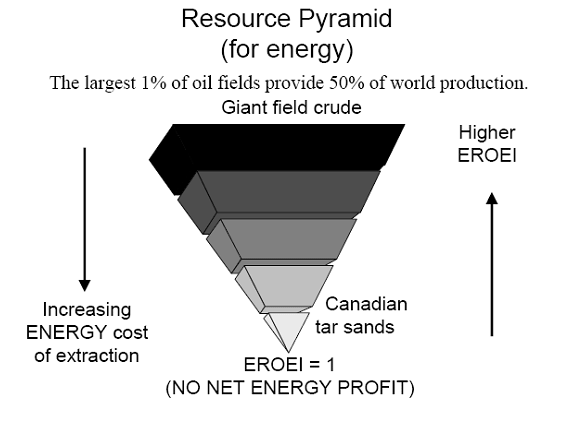This contrasts with those convinced that a peak of oil production is imminent who mostly believe that only about 1 trillion barrels of extractable conventional oil remain. (Note - it is worthwhile remembering that the peak oil concept is about the rate of oil extraction, not the total extractable reserves remaining.)
What the Cornucopians do not seem to understand is that energy must be invested to produce energy. If hydrocarbons are being mined for energy then exploration must occur, wells must be drilled, the oil or gas must be extracted and separated into various fuel grades before further distribution to vehicular fuel tanks. (The process is much more complicated than this but you get the general idea.) It is an energy intensive process.
Earlier in the Oil Age when the most easily accessible oil fields were first tapped a relatively small energy investment gave a huge energy profit - by some estimates a profit ratio of 100-fold or greater.
Advertisement
As oil extraction from a field proceeds the pressure drops requiring more and more energy-intensive methods to be used to continue the extraction - such as pumping down gas or water to maintain pressure and/or pumping up the oil. Also, as the Oil Age has proceeded the size/accessibility of oil fields discovered has decreased (since larger and more accessible fields are easier to find and so are found first) and the more intensive exploration and drilling required to exploit the smaller/less accessible oil fields requires more energy.
If we begin to exploit non-conventional sources of oil then the energy inputs required are greater still, meaning that the net energy produced from each energy unit invested decreases. What this means is that as we use up our highest quality/most accessible hydrocarbon resources and begin to consume lower quality/less accessible resources, the net energy produced from each unit invested decreases.
If the object of the mining activity is net energy production (i.e. the actual energy left over after the inputs to mining, processing and distributing it have been subtracted) then the volume of net energy decreases as the resource quality declines, i.e. as we move down the resource “pyramid”.
In fact, the resource pyramid for net energy resembles more a pyramid standing on its apex! This is shown in the figure below where EROEI is the acronym for Energy Returned on Energy Invested. Once net energy production from the extraction process falls to zero (i.e. EROEI = 1) then it is impossible for the activity to continue (unless the activity is subsidised with energy from another source).

It is true that the world possesses hydrocarbon resources equivalent to many trillions of barrels of oil but these will never be harvested for energy production. It may be that they will be mined, for example, for plastics production at some future date but the energy to do the mining will come from elsewhere.
Advertisement
Many readers may believe that technology will solve this net energy problem by providing less energy intensive methods to extract hydrocarbons from difficult resources. While technology can have a marginal impact, there are some minimum levels of energy investment that cannot be circumvented. For example, the molecular forces holding oil within its constraining rock matrix will always require a certain minimum application of energy to overcome and nothing can magically levitate oil at low pressure up from a deposit several kilometres below ground.
Even if all the low quality hydrocarbon resources could be exploited, the rate at which these difficult deposits could be mined would be low and so would be the rate at which we could obtain energy from them.
The ultimate consequence is that, at some point (“peak net energy”) the rate at which we will obtain energy from fossil sources must decline. An interesting example of this is energy production from coal in the USA. While the tonnage of coal mined in the USA is now at record levels, coal quality is declining and the total energy content of the coal has been decreasing since 1998 (PDF 534KB)!
Also, the total rate of oil production is currently on a plateau and may have peaked but we know that the best grades of oil requiring least processing for gasoline/petrol production (“light sweet crude”) peaked by 2004 and that new oil production is increasingly “heavy and sour”. This, combined with the additional energy required to exploit smaller and more remote oil fields means that we must be at, or close to, the peak rate of net energy production from oil.
The resource pyramid is an interesting concept that allows economists to argue that resources are unlimited. However, like so much economic theory, it is only an illusion supported by cheap and abundant energy.
Note: Factors influencing the resource pyramid concept are discussed in detail in a 2002 article in Geotimes. The authors place great significance on advancement of technology for increasing resource availability but they never mention net energy.
Discuss in our Forums
See what other readers are saying about this article!
Click here to read & post comments.
9 posts so far.